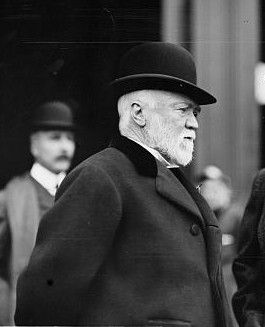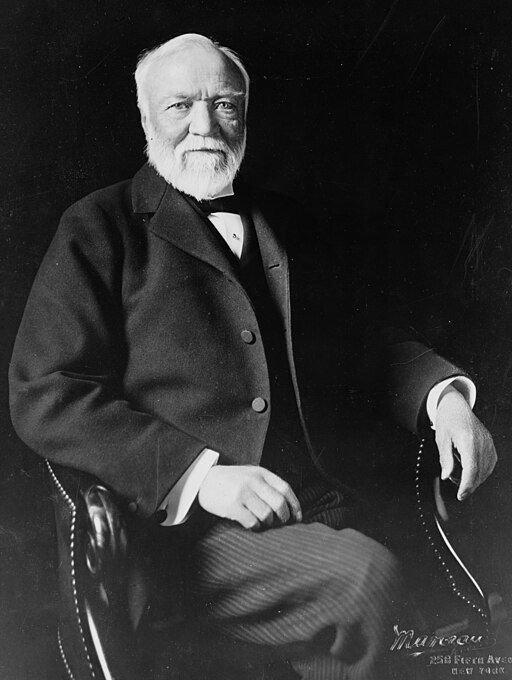Andrew Carnegie and the Peace Palace
- Brent Hecht
- Sep 26, 2023
- 3 min read
Updated: Feb 3, 2024
Andrew Carnegie's Peace Activism
As Andrew Carnegie grew older, he became more focused on philanthropy and becoming an activist for peace among the nations. In 1913, Andrew Carnegie was age 76 and had been retired from business since 1901 when he sold his steel business to JP Morgan for $480 million.
In early May 1913, before traveling to Europe for Wilhelm Kaiser's Silver Jubilee and Dedication of the Peace Palace, he gave a speech at the Fourth American Peace Congress held in St. Louis that year. In his speech he stated,
Let us recognize the truth that man killing man as a means of settling disputes is the crying sin, curse and disgrace of our time...this diabolical practice of man killing man is truly, as has been said, "the foulest fiend ever vomited from the mouth of hell."1
In this same speech, he also stated, "I believe in the League of Peace idea, the formation of an International Police, never for aggression, always for protection..."2
Wilhelm Kaiser II's Silver Jubilee
In June 1913, Andrew Carnegie traveled to Europe for the German Monarch’s silver jubilee, the celebration of Kaiser Wilhelm II's 25th year as monarch. Wilhelm's celebration was one month after another important occasion, Princess Victoria Louise's wedding. Andrew Carnegie hoped to encourage the monarch towards continued peace. It is said that Kaiser Wilhelm II made the statement to Carnegie, “Twenty-five years of peace, Mr. Carnegie, and I hope there will be twenty-five more!” Wilhelm had stated many times that it was a major goal throughout his life to keep peace in Europe.3 However, at the time, there was an arms race among European countries as well as Russia. With the Agadir incident in 1911 visible in the rearview mirror, there were also still tensions between France and Germany. Wilhelm also had more hawkish advisors, such as his Chief of Staff, Conrad von Hotzendorf.4 Nonetheless, Carnegie urged Kaiser Wilhelm II to choose peace and Carnegie received all indications that that was his plan.
Andrew Carnegie and the Peace Palace - YouTube Short

Dedication of the Peace Palace
When Carnegie was finished visiting the monarch in June, the Peace Palace was set to have its inauguration ceremony that August. Carnegie had donated $1.5 million to the project which equates to roughly $50 million today.5 Carnegie's speech at the dedication was accompanied by the unveiling of a bust of Sir Randal Cremer who passed away in 1908. Cremer was a pacifist who led the "international arbitration movement" and received the Nobel Peace Prize in 1903. He was also the original founder of the International Arbitration League.
Mr. Carnegie opened his speech by saying,
My Chairman, my Lords, Ladies, and Gentlemen, My first duty today is to unveil the bust of one of the pioneers of the greatest of all causes--the abolition of war, the killing of man by man, the greatest of all crimes.6
Carnegie went on to refer to Kaiser Wilhelm II's impressive record of peace several times in his speech. Here is one such instance where, despite Germany entering WWI a year later, Mr. Carnegie recognized that Germany's newfound prosperity was a product of its current era of peace.
Surveying the world today, the most striking figure seen is another emperor, the German Emperor, who has recently celebrated his 25th year of peaceful reign, his hands unstained with human blood--a unique record--hence Germany's astounding progress educationally, industrially, and commercially, proving that the greatest of all national blessings is peace.7
After its inauguration, The Peace Palace immediately became the home for the Permanent Court of Arbitration, an intergovernmental organization that resolves disputes among its member nations, which is still there to this day.
The Hague Academy of International Law was started in 1914, but moved into the Peace Palace in 1923 and is still there today. It is a place where higher education is provided to select individuals teaching subjects related to international law.
And finally, since 1913, the Carnegie "Stichting" which is the Dutch word for foundation, has been located in the Peace Palace. The same year that the Rockefeller Foundation began, the Carnegie Foundation moved into its new home in the Peace Palace.
Peace Palace and the League of Nations
The League of Nations formally began in January 1920, and a couple years later, the Peace Palace began housing the International Court of Justice in 1922, which today, and since 1946 has been the judicial body for the United Nations.
The industrialist turned peace advocate and philanthropist, Andrew Carnegie passed away in August 1919 at the age 83.

Sources:
Carnegie, Andrew. Address by Andrew Carnegie. United States: Redfield bros., 1913. 15.
Carnegie, Andrew. Address by Andrew Carnegie. United States: Redfield bros., 1913. 12.
https://www.mentalfloss.com/article/51198/world-war-i-centennial-kaiser-hopes-25-more-years-peace#
Clark, Christopher. The Sleepwalkers: How Europe Went to War in 1914. United States: HarperCollins, 2013. 101
Encyclopedia of Violence, Peace, and Conflict. United States: Elsevier Science, 1999. 697.
The Arbitrator. United Kingdom: International Arbitration League., 1913. 111.
The Arbitrator. 112.
.png)